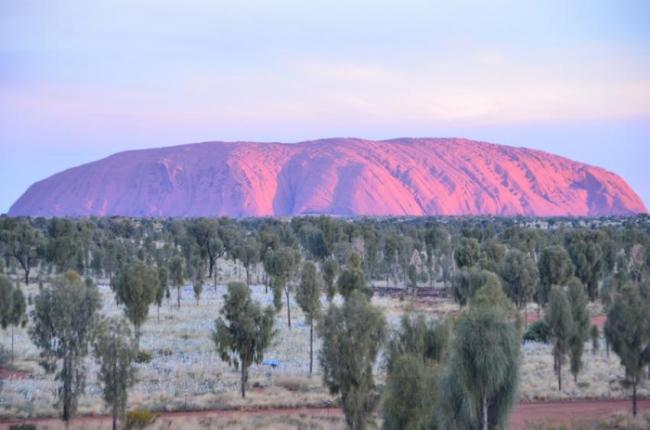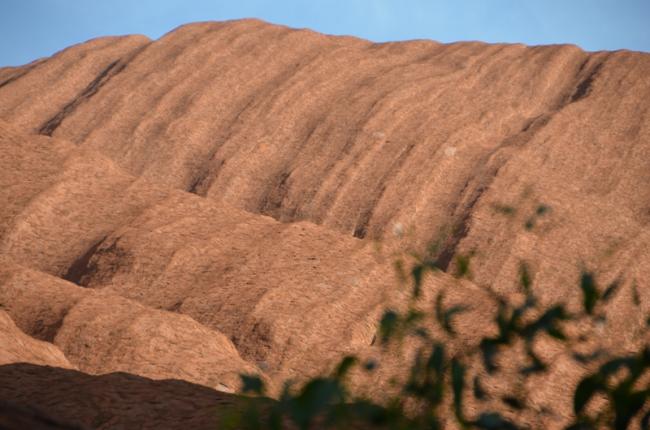
I totally agree with her when visit the iconic Aussie landmark for the third time. It not only stirred me again, but appealed as if I am seeing it for the first time. Such intense is the intrinsic beauty of the sandstone outcrop that it can ignite your inner lust every time you face it.
Surely there are reasons for it.
 First is its incredible scale. When you see it from the aircraft it appears to be of manageable size; same when glimpse from an elevated sun dune near Ayers Rock Resort some 20km away. But when you arrive close you realise how gigantic it is. It’s taller than iconic Eiffel Tower, jutting 348m from its barren surrounds. It has a circumference of 9.4 km covering a total area of 3.3 square km. Most interestingly this monolith rock extends even further below ground to an amount unknown.
First is its incredible scale. When you see it from the aircraft it appears to be of manageable size; same when glimpse from an elevated sun dune near Ayers Rock Resort some 20km away. But when you arrive close you realise how gigantic it is. It’s taller than iconic Eiffel Tower, jutting 348m from its barren surrounds. It has a circumference of 9.4 km covering a total area of 3.3 square km. Most interestingly this monolith rock extends even further below ground to an amount unknown.
Ranked second is the actual colour of the rock which perhaps no one can precisely define. Generally it’s stamped as red, but the hue keeps changing with the sun moving from east to west. Also it very much depends from what angle being viewed, not to be ignored is the viewer’s power of imagination when comparing with tints of blood, bacon, egg yolk, pomegranate and what not.
Perhaps most significant is its spiritual relationship to the local Anangu aboriginal people whose ancestors are said to be living around the rock for 40000 years. From a distance, the rock surface appear pretty even, but when close it’s possible to notice several scars holes and cracks. Each of these geological masterstrokes have an indigenous ancestral story to tell. These legendary tales establishes an empathy with the viewer which draws them back to the rock again and again.
I am a living proof of the above theory being there in person for the third time.
 This time again, I saw the rock awakening at sunrise and hiding into darkness at the end of the day. As usual it was a magical experience to see the monolith illuminated by strokes of diverse colours at different times, all striking as newer shades to me. Climbing to the top of the rock is still possible but not recommended being too dangerous and more importantly being sacred to the indigenous people. So most visitors either takes on designated walks following the footsteps of Anangu ancestors who shaped the landscape.
This time again, I saw the rock awakening at sunrise and hiding into darkness at the end of the day. As usual it was a magical experience to see the monolith illuminated by strokes of diverse colours at different times, all striking as newer shades to me. Climbing to the top of the rock is still possible but not recommended being too dangerous and more importantly being sacred to the indigenous people. So most visitors either takes on designated walks following the footsteps of Anangu ancestors who shaped the landscape.
During my previous visits I undertook the Kuniya walk to Mutitjulu Waterhole and the Mala walk to Kantju Gorge. Both were fascinating and a great learning experience. However I always wanted to circumnavigate the base which the energetic do by either walking or biking. I did it this time riding on a Segway. It was nothing like something that I ventured before, so had lots of fun and thrills going around the entire rock with a guide. Surely at times felt very personal with the rock as if it was just two of us sharing a secret of some kind. Saw the holes and caves very closely, some filled with rock sheltered art.
 The major lure for my third trip was the Field of Light. As the name suggests it’s an extraordinary illumination extravaganza that spreads across the field, edging the rock. As darkness creeps in, over 50000 solar powered and slender stems crowned with radiant frosted-glass spheres illuminates 49,000 square metres of the desert land. Designed by British artist Bruce Munro, this massive artwork comprise of 300000 individual components, which includes 380 km of optical fibre cable and 36 solar portable solar panels to interface with 144 projectors. It took over 2000 hours to design the system in UK and further 3900 hours to recreate it on site. Since opening in April 2016 this colourful showbiz has certainly turned as the biggest crowd puller to Uluru.
The major lure for my third trip was the Field of Light. As the name suggests it’s an extraordinary illumination extravaganza that spreads across the field, edging the rock. As darkness creeps in, over 50000 solar powered and slender stems crowned with radiant frosted-glass spheres illuminates 49,000 square metres of the desert land. Designed by British artist Bruce Munro, this massive artwork comprise of 300000 individual components, which includes 380 km of optical fibre cable and 36 solar portable solar panels to interface with 144 projectors. It took over 2000 hours to design the system in UK and further 3900 hours to recreate it on site. Since opening in April 2016 this colourful showbiz has certainly turned as the biggest crowd puller to Uluru.
Anything you do in Uluru has a style of its own, experiencing the Field of Light was no exception. Our odyssey for the evening began watching the sunset across Uluru from a remote desert location while enjoying canopies and chilled sparkling wine. This was followed by sumptuous buffer dinner under the outback sky. By then the lighting installations had come alive. From a distance, it appeared to me like different varieties of paint randomly splashed on ground. An expert on this high-tech application kept moving from one table to the other and explaining the details of this exhibition as well as briefing us on Bruce Munro and his inspiration of celebrating the significance of a land through lights. After dinner we were ushered through pathways for a close encounter with the art installations, the individual lights then looking like illuminated tulips. Truly it was a magical experience to see gentle rthymes of light on ground under a blazing blanket of southern stars
This lighting exhibition is scheduled to close 30 March 2018.
 Travel Information
Travel Information
Getting There – Air India (www.airindia.com) from Delhi to Sydney and then either Virgin Australia (www.virginaustralia.com) or Jetstar (www.jetstar.com) to Ayers Rock.
Accommodation – Operated by Voyages Indigenous Tourism Australia, Ayers Rock Resort (www.ayersrockresort.com.au) offers variety of accommodations to suit every taste and budget - from 5-star Sails in the Desert, and modern Desert Gardens Hotel, to the self-contained Emu Walk Apartments, the authentic Outback Pioneer Hotel and Lodge, and the Ayers Rock Campground, offering powered campsites and air conditioned cabins. There are several eating options within the resort complex which includes Arnguli Grill for fine dining, Ilkari Restaurant for a tantalizing menu of international flavors and Geckos Café offering nice steaks, pizzas, burgers, salads etc in a relaxed family atmosphere.
Other activities – There are plethora of things from trekking through the desert soils on a camels to exploring the rock and nearby areas by being a passenger on a Harley. For a true aboriginal experience, the SEIT PATJI ( www.seitoutbackaustralia.com) tour is a great option.
Side trip- From Uluru a trip to the iconic Kings Canyon – a massive geological shifting of ancient beauty and intrigue - is highly recommended. Located around 300 plus km away from Uluru, the king of canyons is far from the crowds and off the beaten track in the red desert plain. The most adventures thing to do there is the canyon rim walk. And watching the canyon from a helicopter is an awesome experience. You not only see the canyon but also many wild horses and camels wandering in the plain as only inhabitants of the site. Kings Canyon Resort (www.kingscanyonresort.com.au) offers great accommodation for staying few nights there to enjoy the outback wilderness
Support Our Journalism
We cannot do without you.. your contribution supports unbiased journalism
IBNS is not driven by any ism- not wokeism, not racism, not skewed secularism, not hyper right-wing or left liberal ideals, nor by any hardline religious beliefs or hyper nationalism. We want to serve you good old objective news, as they are. We do not judge or preach. We let people decide for themselves. We only try to present factual and well-sourced news.






